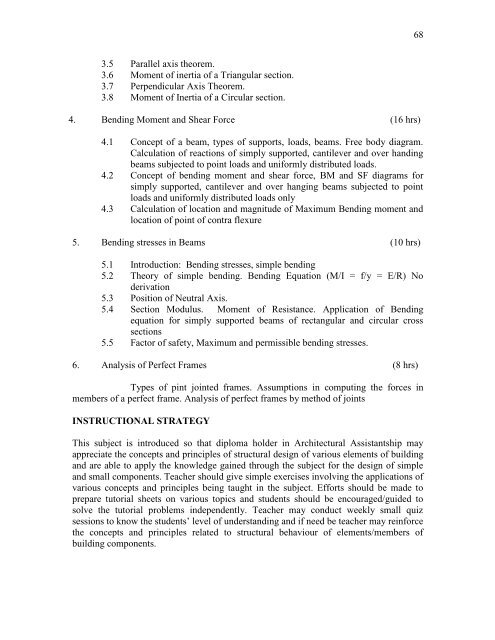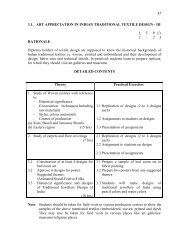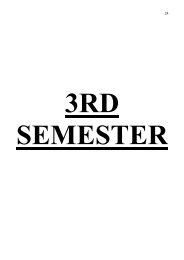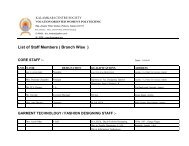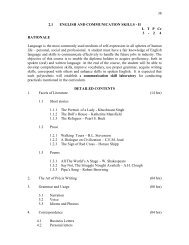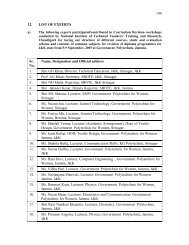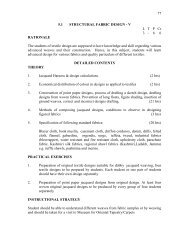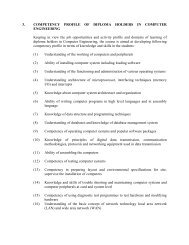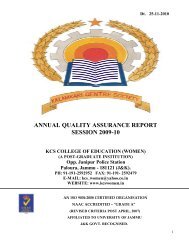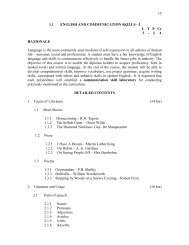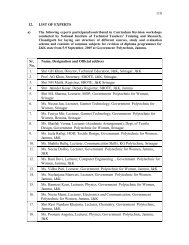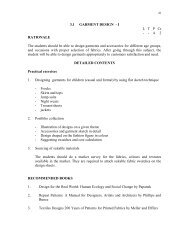53 3.1 BUILDING MATERIALS L T P Cr 3 - - 3 RATIONALE ...
53 3.1 BUILDING MATERIALS L T P Cr 3 - - 3 RATIONALE ...
53 3.1 BUILDING MATERIALS L T P Cr 3 - - 3 RATIONALE ...
You also want an ePaper? Increase the reach of your titles
YUMPU automatically turns print PDFs into web optimized ePapers that Google loves.
68<br />
3.5 Parallel axis theorem.<br />
3.6 Moment of inertia of a Triangular section.<br />
3.7 Perpendicular Axis Theorem.<br />
3.8 Moment of Inertia of a Circular section.<br />
4. Bending Moment and Shear Force (16 hrs)<br />
4.1 Concept of a beam, types of supports, loads, beams. Free body diagram.<br />
Calculation of reactions of simply supported, cantilever and over handing<br />
beams subjected to point loads and uniformly distributed loads.<br />
4.2 Concept of bending moment and shear force, BM and SF diagrams for<br />
simply supported, cantilever and over hanging beams subjected to point<br />
loads and uniformly distributed loads only<br />
4.3 Calculation of location and magnitude of Maximum Bending moment and<br />
location of point of contra flexure<br />
5. Bending stresses in Beams (10 hrs)<br />
5.1 Introduction: Bending stresses, simple bending<br />
5.2 Theory of simple bending. Bending Equation (M/I = f/y = E/R) No<br />
derivation<br />
5.3 Position of Neutral Axis.<br />
5.4 Section Modulus. Moment of Resistance. Application of Bending<br />
equation for simply supported beams of rectangular and circular cross<br />
sections<br />
5.5 Factor of safety, Maximum and permissible bending stresses.<br />
6. Analysis of Perfect Frames (8 hrs)<br />
Types of pint jointed frames. Assumptions in computing the forces in<br />
members of a perfect frame. Analysis of perfect frames by method of joints<br />
INSTRUCTIONAL STRATEGY<br />
This subject is introduced so that diploma holder in Architectural Assistantship may<br />
appreciate the concepts and principles of structural design of various elements of building<br />
and are able to apply the knowledge gained through the subject for the design of simple<br />
and small components. Teacher should give simple exercises involving the applications of<br />
various concepts and principles being taught in the subject. Efforts should be made to<br />
prepare tutorial sheets on various topics and students should be encouraged/guided to<br />
solve the tutorial problems independently. Teacher may conduct weekly small quiz<br />
sessions to know the students’ level of understanding and if need be teacher may reinforce<br />
the concepts and principles related to structural behaviour of elements/members of<br />
building components.


